
Western riding
Encyclopedia

Equestrianism
Equestrianism more often known as riding, horseback riding or horse riding refers to the skill of riding, driving, or vaulting with horses...
which evolved from the ranch
Ranch
A ranch is an area of landscape, including various structures, given primarily to the practice of ranching, the practice of raising grazing livestock such as cattle or sheep for meat or wool. The word most often applies to livestock-raising operations in the western United States and Canada, though...
ing and warfare traditions brought to the Americas by the Spanish
Spain
Spain , officially the Kingdom of Spain languages]] under the European Charter for Regional or Minority Languages. In each of these, Spain's official name is as follows:;;;;;;), is a country and member state of the European Union located in southwestern Europe on the Iberian Peninsula...
Conquistadors, and both equipment and riding style evolved to meet the working needs of the cowboy
Cowboy
A cowboy is an animal herder who tends cattle on ranches in North America, traditionally on horseback, and often performs a multitude of other ranch-related tasks. The historic American cowboy of the late 19th century arose from the vaquero traditions of northern Mexico and became a figure of...
in the American West. American cowboys needed to work long hours in the saddle over rough terrain, sometimes needing to rope cattle with a lariat
Lariat
Lariat can refer to:*A rope in the form of a lasso*Lariat chain, a science demonstration*A professional wrestling move, a variation of a clothesline*A genetic structure in Splicing *Double Lariat, a popular song sung by Luka Megurine...
(or lasso
Lasso
A lasso , also referred to as a lariat, riata, or reata , is a loop of rope that is designed to be thrown around a target and tighten when pulled. It is a well-known tool of the American cowboy. The word is also a verb; to lasso is to successfully throw the loop of rope around something...
). Because of the necessity to control the horse with one hand and use a lariat
Lariat
Lariat can refer to:*A rope in the form of a lasso*Lariat chain, a science demonstration*A professional wrestling move, a variation of a clothesline*A genetic structure in Splicing *Double Lariat, a popular song sung by Luka Megurine...
with the other, western horses were trained to neck rein
Neck rein
A neck rein is a type of indirect rein aid. The horse responds to a neck rein when it has learned that a light pressure of the right rein against its neck on that side means for the horse to turn left, and vice versa....
, that is, to change direction with light pressure of a rein against the horse's neck. Horses were also trained to exercise a certain degree of independence in using their natural instincts to follow the movements of a cow, thus a riding style developed that emphasized a deep, secure seat, and training methods encouraged a horse to be responsive on very light rein contact.
Though the differences in equipment appear dramatic, fewer differences between English
English riding
English riding is a term used to describe a form of horse riding that is seen throughout the world. There are many variations in English riding, but all feature a flat English saddle without the deep seat, high cantle or saddle horn seen on a Western saddle nor the knee pads seen on an Australian...
and Western riding exist than most people think. Both styles require riders to have a solid seat, with the hips and shoulders balanced over the feet, with hands independent of the seat so as to avoid jerking the horse in the mouth and interfering with its performance.
"Western Riding" is also the name for a specific type of event within western competition where a horse performs a pattern that combines trail
Trail (horse show)
Trail is a competitive class at horse shows where horses and riders in western-style attire and horse tack navigate a series of obstacles. Contestants ride the course one at a time...
and reining
Reining
Reining is a western riding competition for horses where the riders guide the horses through a precise pattern of circles, spins, and stops. All work is done at the lope and gallop; the fastest of the horse gaits...
elements.
Tack and equipment
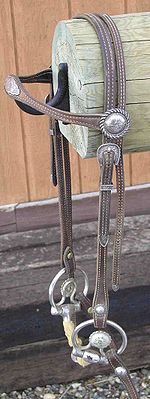
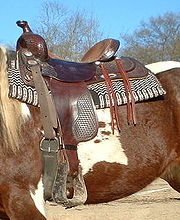
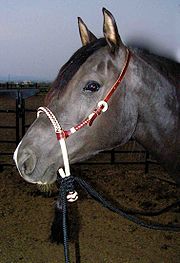
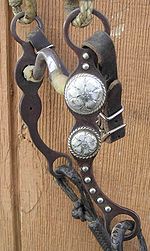
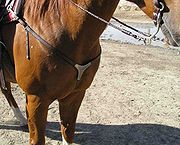
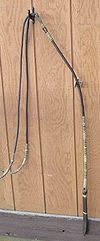
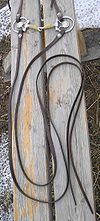
Horse tack
Tack is a term used to describe any of the various equipment and accessories worn by horses in the course of their use as domesticated animals. Saddles, stirrups, bridles, halters, reins, bits, harnesses, martingales, and breastplates are all forms of horse tack...
than was used in "English" disciplines. Covering long distances, and working with half-wild cattle
Cattle
Cattle are the most common type of large domesticated ungulates. They are a prominent modern member of the subfamily Bovinae, are the most widespread species of the genus Bos, and are most commonly classified collectively as Bos primigenius...
, frequently at high speeds in very rough, brushy terrain, meant the ever-present danger of a rider becoming unseated in an accident miles from home and support. Thus, the most noticeable equipment difference is in the saddle
Saddle
A saddle is a supportive structure for a rider or other load, fastened to an animal's back by a girth. The most common type is the equestrian saddle designed for a horse, but specialized saddles have been created for camels and other creatures...
, which has a heavy and substantial tree (traditionally made of wood) to absorb the shock of roping. The western saddle
Western saddle
Western saddles are used for western riding and are the saddles used on working horses on cattle ranches throughout the United States, particularly in the west. They are the "cowboy" saddles familiar to movie viewers, rodeo fans, and those who have gone on trail rides at guest ranches...
features a prominent pommel topped by a horn (a knob used for wrapping a lariat after roping an animal), a deep seat and a high cantle. Depending on the local geography, tapadero
Tapadero
A tapadero, sometimes referred to as a "hooded stirrup," is leather cover over the front of a stirrup on a saddle that closes each stirrup from the front. A tapedero prevents the rider's boot from slipping through and also prevents brush encountered while working cattle on the open range from...
s ("taps") cover the front of the stirrups to prevent brush from catching in the stirrups.
Cowboy boot
Cowboy boot
Cowboy boots refer to a specific style of riding boot, historically worn by cowboys. They have a Cuban heel, rounded to pointed toe, high shaft, and, traditionally, no lacing...
s have pointed toes, higher heels than a traditional boot, and are designed to prevent the rider's foot from slipping through the stirrup
Stirrup
A stirrup is a light frame or ring that holds the foot of a rider, attached to the saddle by a strap, often called a stirrup leather. Stirrups are usually paired and are used to aid in mounting and as a support while using a riding animal...
during a fall and being dragged.
To allow for communication with the horse even with a loose rein, the bridle
Bridle
A bridle is a piece of equipment used to direct a horse. As defined in the Oxford English Dictionary, the "bridle" includes both the headstall that holds a bit that goes in the mouth of a horse, and the reins that are attached to the bit....
also evolved. The biggest difference between "English" and "Western" bridles is the bit
Bit (horse)
A bit is a type of horse tack used in equestrian activities, usually made of metal or a synthetic material, and is placed in the mouth of a horse or other equid and assists a rider in communicating with the animal. It rests on the bars of the mouth in an interdental region where there are no teeth...
. Most finished "Western" horses are expected to eventually perform in a curb bit
Curb bit
A curb bit is a type of bit used for riding horses that uses lever action. It includes the pelham bit and the Weymouth curb along with the traditional "curb bit" used mainly by Western riders....
with a single pair of rein
Rein
Reins are items of horse tack, used to direct a horse or other animal used for riding or driving. Reins can be made of leather, nylon, metal, or other materials, and attach to a bridle via either its bit or its noseband.-Use for riding:...
s that has somewhat longer and looser shanks than the curb of an English Double bridle
Double bridle
A double bridle, also called a full bridle or Weymouth bridle, is a bridle that has two bits and four reins . One bit is the bradoon , is a modified snaffle bit that is smaller in diameter and has smaller bit rings than a traditional snaffle, and it is adjusted so that it sits above and behind the...
or a pelham bit
Pelham bit
A pelham bit is a type of bit used when riding a horse. It has elements of both a curb bit and a snaffle bit. In this respect a pelham bit functions similar to a double bridle, and like a double bridle it normally has "double" reins: a set of curb reins and a set of snaffle reins. Because it has...
. Two styles of Western reins developed: The long split reins of the Texas tradition, which are completely separated, or the closed-end "Romal
Romal
A Romal , is a type of long quirt attached to the end of a set of closed reins that are connected to the bridle of a horse. It is not to be used to strike a horse, but rather was a tool used to assist in moving cattle....
" reins of the California tradition, which have a long single attachment on the ends that can be used as a quirt
Quirt
A quirt is a forked type of stock whip which usually has two falls at the end . Sometimes called a riding quirt, horse quirt, or a dog quirt.The falls on a quirt are made of leather, buffalo, or cow hide...
. Young horses are usually started under saddle
Horse training
Horse training refers to a variety of practices that teach horses to perform certain behaviors when asked to do so by humans. Horses are trained to be manageable by humans for everyday care as well as for equestrian activities from horse racing to therapeutic horseback riding for people with...
with either a simple snaffle bit, or with the classic tool of the vaquero
Cowboy
A cowboy is an animal herder who tends cattle on ranches in North America, traditionally on horseback, and often performs a multitude of other ranch-related tasks. The historic American cowboy of the late 19th century arose from the vaquero traditions of northern Mexico and became a figure of...
, the bosal
Bosal
A bosal is a type of noseband used on the classic hackamore of the vaquero tradition. It is usually made of braided rawhide and is fitted to the horse in a manner that allows it to rest quietly until the rider uses the reins to give a signal. It acts upon the horse's nose and jaw...
-style hackamore
Hackamore
A hackamore is a type of animal headgear which does not have a bit. Instead, it has a special type of noseband that works on pressure points on the face, nose, and chin...
.
Rider attire
The clothing of the Western rider differs from that of the "EnglishEnglish riding
English riding is a term used to describe a form of horse riding that is seen throughout the world. There are many variations in English riding, but all feature a flat English saddle without the deep seat, high cantle or saddle horn seen on a Western saddle nor the knee pads seen on an Australian...
" style dressage
Dressage
Dressage is a competitive equestrian sport, defined by the International Equestrian Federation as "the highest expression of horse training." Competitions are held at all levels from amateur to the World Equestrian Games...
, hunt seat
Hunt seat
Hunt seat is terminology used in the United States and Canada to refer to a style of forward seat riding commonly found at American horse shows. Along with Dressage, it is one of the two classic forms of English riding. The Hunt seat is based on the tradition of fox hunting...
or Saddle seat
Saddle seat
Saddle Seat is a style of horseback riding within the category of English riding that is designed to show off the high trotting action of certain horse breeds. The style developed into its modern form in the United States, and is also seen in Canada and South Africa...
rider. Practical Western attire consists of a long-sleeved work shirt, denim jeans, boots, and a wide-brimmed cowboy hat
Cowboy hat
The cowboy hat is a high-crowned, wide-brimmed hat best known as the defining piece of attire for the North American cowboy. Today it is worn by many people, and is particularly associated with ranch workers in the western and southern United States, western Canada and northern Mexico, with...
. Usually a rider wears protective leather leggings called "chaps
Chaps
Chaps are sturdy coverings for the legs consisting of leggings and a belt. They are buckled on over trousers with the chaps' integrated belt, but unlike trousers they have no seat and are not joined at the crotch. They are designed to provide protection for the legs and are usually made of leather...
" to help the rider stick to the saddle and to protect the legs when riding through brush. Clean, well-fitting work clothing is the usual outfit seen in rodeo
Rodeo
Rodeo is a competitive sport which arose out of the working practices of cattle herding in Spain, Mexico, and later the United States, Canada, South America and Australia. It was based on the skills required of the working vaqueros and later, cowboys, in what today is the western United States,...
, cutting
Cutting (sport)
Cutting is an equestrian event in the western riding style where a horse and rider are judged on their ability to separate a single animal away from a cattle herd and keep it away for a short period of time.-Description:...
and reining
Reining
Reining is a western riding competition for horses where the riders guide the horses through a precise pattern of circles, spins, and stops. All work is done at the lope and gallop; the fastest of the horse gaits...
competitions, especially for men, though sometimes in brighter colors or finer fabrics.
Show equipment
Some competitive events may use flashier equipment. Unlike the English traditions where clothing and tack is quiet and unobtrusive, Western showHorse show
A Horse show is a judged exhibition of horses and ponies. Many different horse breeds and equestrian disciplines hold competitions worldwide, from local to the international levels. Most horse shows run from one to three days, sometimes longer for major, all-breed events or national and...
equipment is intended to draw attention. Saddles, bits and bridle
Bridle
A bridle is a piece of equipment used to direct a horse. As defined in the Oxford English Dictionary, the "bridle" includes both the headstall that holds a bit that goes in the mouth of a horse, and the reins that are attached to the bit....
s are frequently ornamented with substantial amounts of silver
Silver
Silver is a metallic chemical element with the chemical symbol Ag and atomic number 47. A soft, white, lustrous transition metal, it has the highest electrical conductivity of any element and the highest thermal conductivity of any metal...
. The rider's shirt is often replaced with a jacket, and women's clothing in particular may feature vivid colors and even, depending on current fads, rhinestones or sequins. Hats and chaps are often color-coordinated, spurs and belt buckles are often silver-plated, and women's scarf pins and, when worn, men's bolo ties
Bola tie
A bolo tie is a type of necktie consisting of a piece of cord or braided leather with decorative metal tips or aglets secured with an ornamental clasp or slide....
are also ornamented with silver or even semi-precious gemstones.
Western competitive events
Competition for western riders at horse showHorse show
A Horse show is a judged exhibition of horses and ponies. Many different horse breeds and equestrian disciplines hold competitions worldwide, from local to the international levels. Most horse shows run from one to three days, sometimes longer for major, all-breed events or national and...
s and related activities include in the following events:
- Western pleasureWestern PleasureWestern Pleasure is a western style competition at horse shows that evaluates horses on manners and suitability of the horse for a relaxed but collected gait cadence and relatively slow speed of gait, along with calm and responsive disposition. The horse is to appear to be a "pleasure" to ride and...
- the rider must show the horse together with other horses in an arena at a walk, jog (a slow, controlled trotTrot (horse gait)The trot is a two-beat diagonal gait of the horse, where the diagonal pairs of legs move forward at the same time. There is a moment of suspension between each beat....
), and lope (a slow, controlled canterCanterThe canter is a controlled, three-beat gait performed by a horse. It is a natural gait possessed by all horses, faster than most horses' trot but slower than the gallop, and is used by all riders. The speed of the canter varies between 16-27 km/h , depending on the length of the stride of the horse...
). In some breed competitions, a judge may ask for an extended canter and/or a hand gallop, and, less often, an extension of the jog. The horse must remain under control on a loose rein, with low head carriage, the rider directing the horse with nearly invisible aids and minimal interference. - ReiningReiningReining is a western riding competition for horses where the riders guide the horses through a precise pattern of circles, spins, and stops. All work is done at the lope and gallop; the fastest of the horse gaits...
- considered by some the "dressageDressageDressage is a competitive equestrian sport, defined by the International Equestrian Federation as "the highest expression of horse training." Competitions are held at all levels from amateur to the World Equestrian Games...
" of the western riding world, with FEIInternational Federation for Equestrian SportsThe Fédération Équestre Internationale or in English, the International Federation for Equestrian Sports, is the international governing body of equestrian sports. It recognizes ten international disciplines...
-recognized status as a new international discipline at the World Equestrian GamesWorld Equestrian GamesThe FEI World Equestrian Games are the major international championships for equestrianism, and administered by the Fédération Equestre Internationale . The games have been held every four years, halfway between sets of consecutive Summer Olympic Games, since 1990...
, reining requires horse and rider to perform a precise pattern consisting of circles at a lope and gallop with flying changes of lead, rapid "spins" (a turn in one spot on the haunches), "rollbacks" (a rapid turn immediately followed by a gallop in the opposite direction) and the crowd-pleasing sliding stop (executed from a full gallop). - CuttingCutting (sport)Cutting is an equestrian event in the western riding style where a horse and rider are judged on their ability to separate a single animal away from a cattle herd and keep it away for a short period of time.-Description:...
- this event highlights the "cow sense" prized in stock horses. The horse and rider select and separate a cow (or steer) out of small herd of 10-20 animals. When the cow tries to return to the herd, the rider relaxes the reins and leaves it entirely to the horse to keep the cow from returning to the herd. Depending on the level of competition, one to three judges award points to each competitor. - Working cow horseWorking cow horseWorking cow horse is a type of competition, known also as reined cow horse, where horses are asked to work a single live cow in an arena, performing specific maneuvers that include circling the cow, turning it in a specified manner, and performing a reining pattern...
- also called Reined cow horse. A judged competition that is something of a cross between cutting and reining. A horse and rider team work a single cow in an arena, making the cow move in a directed fashion through several maneuvers. - Ranch horse: An event that, depending on breed sanctioning organization, tests multiple categories used by working ranch horses: Ranch riding, which is similar to western pleasure; Ranch trail, testing tasks performed during ranch work, often judged on natural terrain rather than in an arena; Ranch Cutting, judged the same as a cuttingCutting (sport)Cutting is an equestrian event in the western riding style where a horse and rider are judged on their ability to separate a single animal away from a cattle herd and keep it away for a short period of time.-Description:...
event; Working ranch horse, combining Reining, Roping, and working cow horse; and ranch conformation and is judged like a halter class. - "Western Riding"Western riding (horse show)Western Riding is a competitive event at American horse shows, particularly those for stock horse breeds such as the American Quarter Horse. It is not to be confused with the general term "western riding," referring to the many forms of equestrianism where riders use a western saddle; instead, it...
Western Riding is a class that judges horses on a pattern, evaluating smooth gaits, flying lead changes, responsiveness to the rider, manners, and disposition. - Team penningTeam penningTeam penning is a western equestrian sport that evolved from the common ranch work of separating cattle into pens for branding, doctoring, or transport....
: a timed event in which a team of 3 riders must select 3 to 5 marked steers out of a herd and drive them into a small pen. The catch: riders cannot close the gate to the pen till they have corralled all the cattle (and only the intended cattle) inside. The fastest team wins, and teams exceeding a given time limit are disqualified. A related event is Ranch sortingRanch SortingRanch Sorting is a western-style equestrian sport that evolved from the common ranch work of separating cattle into pens for branding, doctoring, or transport. Ranch Sorting is an event that pits a team of two riders on horseback against the clock... - Trail classTrail (horse show)Trail is a competitive class at horse shows where horses and riders in western-style attire and horse tack navigate a series of obstacles. Contestants ride the course one at a time...
: in this event, the rider has to maneuver the horse through an obstacle course in a ring. Horses must cross bridges, logs and other obstacles; stand quietly while a rider waves a flapping object around the horse; sidepass (to move sideways), often with front and rear feet on either side or a rail; make 90 and 180 degree turns on the forehand or haunches, back up, sometimes while turning, open and close a gate while mounted, and other maneuvers relevant (distantly) to everyday ranchRanchA ranch is an area of landscape, including various structures, given primarily to the practice of ranching, the practice of raising grazing livestock such as cattle or sheep for meat or wool. The word most often applies to livestock-raising operations in the western United States and Canada, though...
or trail ridingTrail ridingTrail riding sometimes called horse or pony trekking is riding outdoors on natural trails and roads as opposed to riding in an enclosed area such as a riding arena. The term may encompass those who travel on horses, on mountain bikes, or on motorcycles and other motorized all-terrain vehicles...
. While speed isn't judged, horses have a limited amount of time to complete each obstacle and can be penalized for refusing an obstacle or exceeding the allotted time. - HalterHalter (horse show)"Halter" is a term used to describe a type of horse show class where horses are shown "in hand," meaning that they are led, not ridden, and are judged on their conformation and suitability as breeding stock...
- also sometimes called "conformation" or "breeding" classes, the conformation of the horse is judged, with emphasis on the both the movement and build of the horse. The horse is not ridden, but is led, shown in a halterHalterA halter, headcollar, or, less often, headstall, is headgear that is used to lead or tie up livestock and, occasionally, other animals; it fits behind the ears , and around the muzzle. To handle the animal, usually a lead rope or lead shank is attached...
by a handler controlling the horse from the ground using a lead rope. - Halter ShowmanshipHorse showmanshipShowmanship is an event found at many horse shows. The class is also sometimes called "Fitting and Showmanship", "Showmanship In-Hand", "Showmanship at Halter" or "Halter Showmanship" It involves a person on the ground leading a horse, wearing a halter or bridle, through a series of maneuvers...
, also called (depending on region, breed, and rule book followed) Showmanship at Halter, Youth Showmanship, Showmanship in-hand or Fitting and Showmanship - In showmanship classes the performance of the handler is judged, as well as the cleanliness and grooming of horse, equipment and handler's attire, with the behavior of the horse also considered part of the handler's responsibility. The competitor is judged on his or her ability to fit and present the halter horse to its best advantage. The horse is taken through a short pattern where the horse and handler must set up the horse correctly at a standstill and exhibit full control while at a walk, jog, turning and in more advanced classes, pivoting and backing up. Clothing of the handlers tend to parallel that of western pleasure competition. Halters are leather ornamented with silver. Showmanship classes are popular at a wide range of levels, from children who do not yet have the skill or confidence to succeed in riding events, to large and competitive classes at the highest levels of national show competition.
Western Equitation
Western equitationEquitation
Equitation is the art or practice of horse riding or horsemanship.More specifically, equitation may refer to a rider's position while mounted, and encompass a rider's ability to ride correctly and with effective aids. In horse show competition, the rider, rather than the horse is evaluated...
(sometimes called western horsemanship, stock seat equitation, or, in some classes, reining seat equitation) competitions are judged at the walk, jog
Trot (horse gait)
The trot is a two-beat diagonal gait of the horse, where the diagonal pairs of legs move forward at the same time. There is a moment of suspension between each beat....
, and lope
Canter
The canter is a controlled, three-beat gait performed by a horse. It is a natural gait possessed by all horses, faster than most horses' trot but slower than the gallop, and is used by all riders. The speed of the canter varies between 16-27 km/h , depending on the length of the stride of the horse...
in both directions. Riders must sit to the jog and never post.
In a Western equitation class a rider may be asked to perform a test or pattern, used to judge the rider's position and control of the horse
Riding aids
Riding aids are the cues a rider gives to a horse to communicate what they want the animal to do. Riding aids are broken into the natural aids and the artificial aids.-Natural aids:...
. Tests may be as simple as jogging in a circle or backing up, or as complex as a full reining pattern
Reining
Reining is a western riding competition for horses where the riders guide the horses through a precise pattern of circles, spins, and stops. All work is done at the lope and gallop; the fastest of the horse gaits...
, and may include elements such as transitions from halt to lope or lope to halt, sliding stops, a figure-8 at the lope with simple or flying change of lead, serpentines at the lope with flying changes, the rein back, a 360 degree or greater spin or pivot, and the rollback.
Riders must use a western saddle and a curb bit
Curb bit
A curb bit is a type of bit used for riding horses that uses lever action. It includes the pelham bit and the Weymouth curb along with the traditional "curb bit" used mainly by Western riders....
, and may only use one hand to hold the reins while riding. Two hands are allowed if the horse is ridden in a snaffle bit or hackamore
Hackamore
A hackamore is a type of animal headgear which does not have a bit. Instead, it has a special type of noseband that works on pressure points on the face, nose, and chin...
, which are only permitted for use on "junior" horses, defined differently by various breed associations, but usually referring to horses four or five years of age and younger. Horses are not allowed to wear a noseband
Noseband
A noseband is the part of a horse's bridle that encircles the nose and jaw of the horse. In English riding, where the noseband is separately attached to its own headstall or crownpiece, held independently of the bit, it is often called a cavesson or caveson noseband...
or cavesson, nor any type of protective boot or bandage, except during some tests that require a reining pattern.
Riders are allowed two different styles of rein
Rein
Reins are items of horse tack, used to direct a horse or other animal used for riding or driving. Reins can be made of leather, nylon, metal, or other materials, and attach to a bridle via either its bit or its noseband.-Use for riding:...
s: 1) split reins, which are not attached to one another, and thus the rider is allowed to place one finger between the reins to aid in making adjustments; and 2) "romal reins," which are joined together and have a romal
Romal
A Romal , is a type of long quirt attached to the end of a set of closed reins that are connected to the bridle of a horse. It is not to be used to strike a horse, but rather was a tool used to assist in moving cattle....
(a type of long quirt
Quirt
A quirt is a forked type of stock whip which usually has two falls at the end . Sometimes called a riding quirt, horse quirt, or a dog quirt.The falls on a quirt are made of leather, buffalo, or cow hide...
) on the end, which the rider holds in their non-reining hand, with at least 16 inches of slack between the two, and the rider is not allowed to place a finger between the reins.
The correct position for this discipline, as in all forms of riding, is a balanced seat. This is seen when a bystander can run an imaginary straight line that passes through the rider's ear, shoulder, hip, and heel. This means the rider's feet and legs must hang directly in balance so that the heel hits this line, with heels down. The rider should also be sitting as straight as possible, but with their hips under their body, sitting firmly on their seat bones, not sitting on one's crotch with an arched back. The rider should have their weight sunk into their seat and distributed through their legs. The rider's shoulders should be rolled back and their chin up to show that they are looking forward.
The western style is seen in a long stirrup
Stirrup
A stirrup is a light frame or ring that holds the foot of a rider, attached to the saddle by a strap, often called a stirrup leather. Stirrups are usually paired and are used to aid in mounting and as a support while using a riding animal...
length, often longer than even that used by dressage
Dressage
Dressage is a competitive equestrian sport, defined by the International Equestrian Federation as "the highest expression of horse training." Competitions are held at all levels from amateur to the World Equestrian Games...
riders, an upright posture (equitation riders are never to lean forward beyond a very slight inclination), and the distinctive one-handed hold on the reins. The reining hand should be bent at the elbow, held close to the rider's side, and centered over the horse's neck, usually within an inch of the saddle horn. Due to the presence of the saddle horn, a true straight line between rider's hand and horse's mouth is usually not possible. Common faults of western riders include slouching, hands that are too high or too low, and poor position, particularly a tendency to sit on the horse as if they were sitting in a chair, with their feet stuck too far forward. While this "feet on the dashboard" style is used by rodeo riders to stay on a bucking horse, it is in practice an ineffective way to ride.
See also
- Australian rodeoAustralian rodeoRodeos have long been a popular competitor and spectator sport in Australia, but were not run on an organized basis until the 1880s.-History:Newspaper reports recorded public roughriding events that took place in Victoria during the 1880s...
- CowboyCowboyA cowboy is an animal herder who tends cattle on ranches in North America, traditionally on horseback, and often performs a multitude of other ranch-related tasks. The historic American cowboy of the late 19th century arose from the vaquero traditions of northern Mexico and became a figure of...
- Cutting (sport)Cutting (sport)Cutting is an equestrian event in the western riding style where a horse and rider are judged on their ability to separate a single animal away from a cattle herd and keep it away for a short period of time.-Description:...
- EquitationEquitationEquitation is the art or practice of horse riding or horsemanship.More specifically, equitation may refer to a rider's position while mounted, and encompass a rider's ability to ride correctly and with effective aids. In horse show competition, the rider, rather than the horse is evaluated...
- Halter (horse show)Halter (horse show)"Halter" is a term used to describe a type of horse show class where horses are shown "in hand," meaning that they are led, not ridden, and are judged on their conformation and suitability as breeding stock...
- Horse showmanshipHorse showmanshipShowmanship is an event found at many horse shows. The class is also sometimes called "Fitting and Showmanship", "Showmanship In-Hand", "Showmanship at Halter" or "Halter Showmanship" It involves a person on the ground leading a horse, wearing a halter or bridle, through a series of maneuvers...
- ReiningReiningReining is a western riding competition for horses where the riders guide the horses through a precise pattern of circles, spins, and stops. All work is done at the lope and gallop; the fastest of the horse gaits...
- RodeoRodeoRodeo is a competitive sport which arose out of the working practices of cattle herding in Spain, Mexico, and later the United States, Canada, South America and Australia. It was based on the skills required of the working vaqueros and later, cowboys, in what today is the western United States,...
- Western pleasureWestern PleasureWestern Pleasure is a western style competition at horse shows that evaluates horses on manners and suitability of the horse for a relaxed but collected gait cadence and relatively slow speed of gait, along with calm and responsive disposition. The horse is to appear to be a "pleasure" to ride and...
- Working cow horseWorking cow horseWorking cow horse is a type of competition, known also as reined cow horse, where horses are asked to work a single live cow in an arena, performing specific maneuvers that include circling the cow, turning it in a specified manner, and performing a reining pattern...
- Western saddleWestern saddleWestern saddles are used for western riding and are the saddles used on working horses on cattle ranches throughout the United States, particularly in the west. They are the "cowboy" saddles familiar to movie viewers, rodeo fans, and those who have gone on trail rides at guest ranches...

